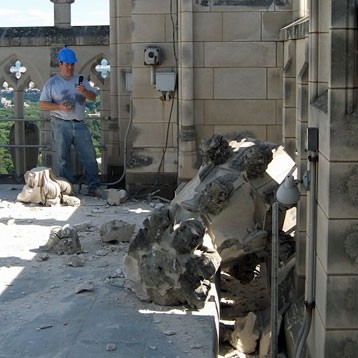
One of the most revered of churches, the Washington National Cathedral, sustained millions in damages from the 5.8 earthquake that hit the D.C. area two days ago.
The spires of the Cathedral, the tallest structures in the Capitol, sustained significant damage as several were sheared off and the bases shifted.
An angel lies broken in front of the Cathedral. Â Since 1912, the Cathedral has been a national place of worship as well as host to state funerals, presidential memorial services, and served as a spiritual home for our country in times of crisis.
A worker assesses further damage to the Cathedral, which is now closed. Services for the time being will be shifted to the National Hebrew Cathedral.
Washington, D.C.—In a briefing with reporters today, Washington National Cathedral Dean Samuel T. Lloyd III announced that the Cathedral will remain closed to the public at least through Saturday, August 27, as engineers fully assess the damage to the building from Tuesday’s 5.8-magnitude earthquake. Because of the handcrafted nature of the Cathedral’s stonework, cost estimates for repairs are likely to be in the range of millions of dollars—none of which is believed to be covered by the Cathedral’s insurance. "The Cathedral building represents the grandeur and beauty of faith—its importance to American life and indeed to human life. But yesterday’s earthquake reminds us that no finite building is God. We will move forward with our faith unshaken, and we will repair the building. Help from the countless Americans who helped build the Cathedral in the first place will make it whole again," said Dean Lloyd at the press conference. Because of this decision, Saturday’s prayer service celebrating the dedication of the Martin Luther King, Jr. Memorial has been moved to the Basilica of the National Shrine of the Immaculate Conception located on the campus of the Catholic University of America. Plans for the Cathedral’s Sunday worship services will be announced once they are finalized. The Cathedral’s commemoration of the tenth anniversary of September 11, "A Call to Compassion" is expected to move forward as planned, including a performance of the Brahms Requiem on Friday, September 9, by the Marine Chamber Orchestra and the United States Navy Band Sea Chanters with the Cathedral Choir and "A Concert to Heal," the evening of Sunday, September 11, featuring artists Denyce Graves, Alan Jackson, and Patti LaBelle. Dean Lloyd was joined at the press conference by Cathedral Head Stone Mason Joe Alonso and the engineering team evaluating the damage to the Cathedral, including consulting engineer James Madison Cutts, who worked with the Cathedral on the restoration to the central tower in the 1990s; John Tung, a structural engineer from the firm Keast and Hood; and architect Anthony Segretti, who served as the superintending architect at the Cathedral from 1981 until the building’s completion in 1990 and has remained a consulting surveyor of the building since. The highest elevated point of Washington, D.C., the "Gloria in Excelsis" central tower of Washington National Cathedral, sustained significant damage in yesterday’s earthquake. Three of four pinnacles (corner spires) on the central tower have been damaged. Specifically, three "finials" (capstones shaped like fleurs-de-lys) have fallen from them, with more significant damage to two of the pinnacles. Similar decorative elements on the Cathedral’s exterior also appear to be damaged. Cracks have appeared in the flying buttresses around the apse at the Cathedral’s east end, the first portion of the building to be constructed, but the buttresses supporting the central tower seem to be sound. No individuals were injured either within the Cathedral or on its grounds. Despite some cracks on upper floors in the interior, no damage to the stained-glass windows has been reported. The building has been closed to visitors until further notice. The central tower was completed in the 1960s and benefited from a restoration in the 1990s after repeatedly sustaining lightning damage. Constructed in fourteenth-century English "perpendicular" Gothic style, Washington National Cathedral is the sixth-largest Cathedral in the world and the second-largest such church in the United States. It was constructed between 1907 and 1990. Erected on Mount St. Alban, the most commanding hill in the District of Columbia, Washington National Cathedral rises to a greater height than the Washington Monument, which also is closed now because of cracks that have started appearing.  https://www.nationalcathedral.org/press/PR-5AOMI-G7001F.shtml
>



